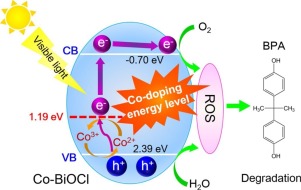Applied Catalysis B: Environment and Energy ( IF 20.2 ) Pub Date : 2017-09-18 , DOI: 10.1016/j.apcatb.2017.09.036 Chu-Ya Wang , Ying-Jie Zhang , Wei-Kang Wang , Dan-Ni Pei , Gui-Xiang Huang , Jie-Jie Chen , Xing Zhang , Han-Qing Yu

|
Bismuth oxychloride (BiOCl) is a typical UV-light-sensitive photocatalyst with a unique layered structure, but exhibits no response towards visible light. This is a main limitation for its practical applications in photocatalytic degradation of pollutants. Among various methods to expand the light absorption region, doping modification is an efficient approach because it can tailor the band structure by forming a doping energy level without changing the layered structure substantially. In this case, the static electric field in the BiOCl crystal can be retained. Since cobalt (Co) exhibits good electrochemical properties, it is an ideal element for doping modification to expand the light absorption region and enhance the charge separation efficiency of BiOCl. In this work, Co-doped BiOCl nanosheets were prepared using a simple hydrothermal route. The doped Co expanded the light absorption region and enhanced the charge separation efficiency by forming a doping energy level in the band gap of BiOCl. As a result, the Co-BiOCl nanosheets exhibited an outstanding photocatalytic performance in degrading bisphenol A (BPA) under visible light irradiation with a degradation rate of 3.5 times higher than that of BiOCl. On the basis of the experimental results and density functional theory calculations, the mechanism of visible-light-driven catalytic BPA degradation by the Co-BiOCl nanosheets was elucidated. Therefore, the feasibility of Co-doping modification for BiOCl was confirmed, and a novel and efficient strategy was provided for the design and synthesis of high-performance photocatalysts.
中文翻译:

共掺杂BiOCl纳米片在可见光照射下增强的双酚A光催化降解
氯氧化铋(BiOCl)是典型的紫外线敏感的光催化剂,具有独特的层状结构,但对可见光无响应。这是其在污染物的光催化降解中的实际应用的主要限制。在扩大光吸收区域的各种方法中,掺杂改性是一种有效的方法,因为它可以通过形成掺杂能级来定制能带结构,而无需实质上改变分层结构。在这种情况下,可以保持BiOCl晶体中的静电场。由于钴(Co)表现出良好的电化学性能,因此它是进行掺杂改性以扩大光吸收区域并提高BiOCl电荷分离效率的理想元素。在这项工作中,使用简单的水热途径制备了Co-掺杂的BiOCl纳米片。掺杂的Co通过在BiOCl的带隙中形成掺杂能级而扩大了光吸收区域并提高了电荷分离效率。结果,Co-BiOCl纳米片在可见光照射下降解双酚A(BPA)时表现出优异的光催化性能,其降解速率比BiOCl的降解速率高3.5倍。根据实验结果和密度泛函理论计算,阐明了Co-BiOCl纳米片对可见光驱动的催化双酚A降解的机理。因此,证实了BiOCl的共掺杂改性的可行性,并为高性能光催化剂的设计和合成提供了新颖有效的策略。











































 京公网安备 11010802027423号
京公网安备 11010802027423号